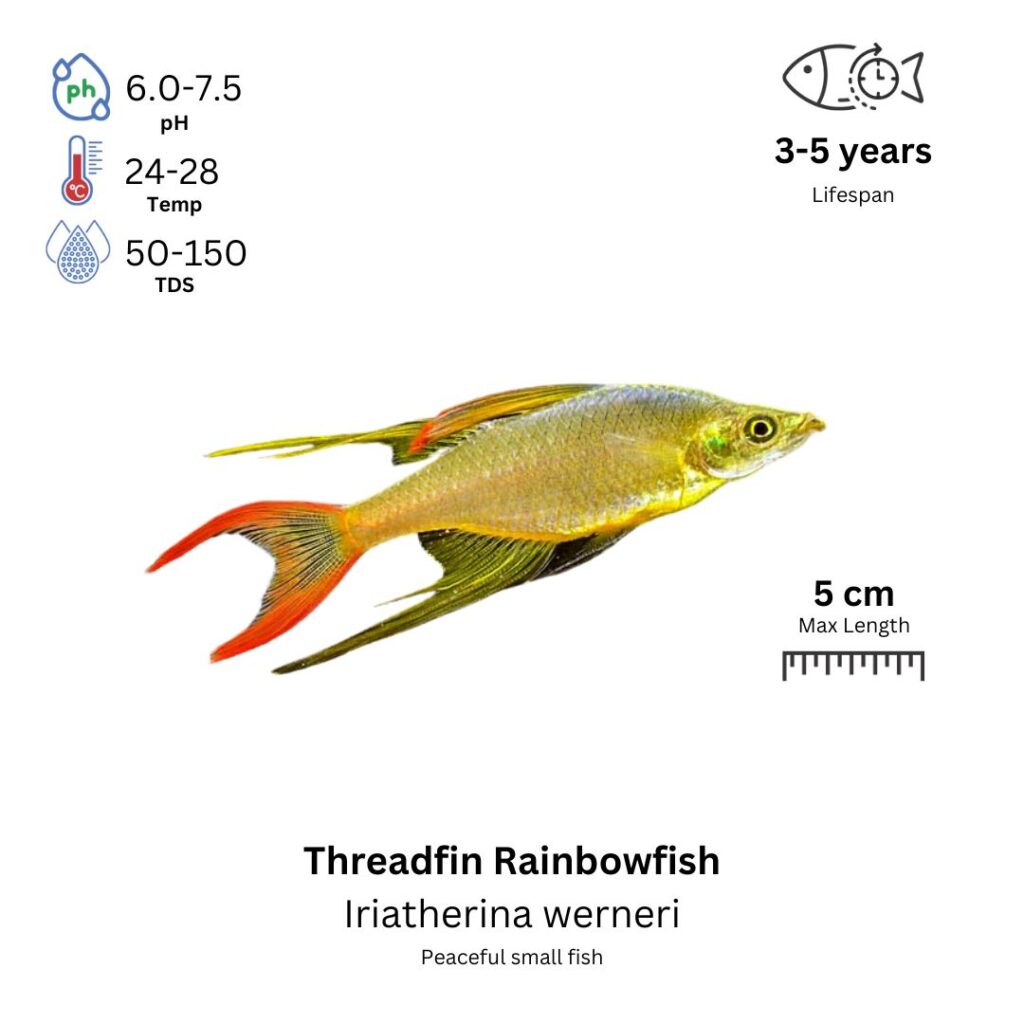Threadfin Rainbowfish
Iriatherina werneri

Description
Threadfin Rainbowfish are known for their elegant appearance, with a slender, elongated body and long, flowing fins. The males of this species are particularly striking, displaying vibrant colors such as blue, yellow, and orange, especially along the body and tail. The most distinguishing feature of the Threadfin Rainbowfish is its long, delicate thread-like extensions on the tail and dorsal fins, giving it a graceful, threadfin-like appearance. Females are typically less colorful but still retain the shimmering quality typical of rainbowfish. These fish are peaceful, active, and social, thriving in schools and making them ideal for community tanks.
Habitat Origin
Native to the freshwater streams and rivers of Papua New Guinea and northern Australia, particularly in slow-moving, clear waters with plenty of vegetation and submerged structures like rocks and roots. Threadfin Rainbowfish prefer areas with stable water conditions and moderate to slow water flow.
Aquarium
Ideal Number in Aquarium: At least 6 individuals, as they are schooling fish and feel more secure in groups.
Favorite Food

Threadfin Rainbowfish are omnivores and will accept a variety of foods, including high-quality flake food, micro pellets, and live or frozen foods like brine shrimp, daphnia, and bloodworms. They also appreciate some plant matter and algae, making them suitable for planted tanks. A varied diet is important to maintain their health and vibrant coloration.
Behavior:
Threadfin Rainbowfish are peaceful and social fish that thrive in schools. They are active swimmers, often seen darting through the middle and upper levels of the tank. Their schooling behavior is more prominent when they are kept in groups of at least 6, where they can interact and show off their natural vibrant colors. These fish are generally calm, though the males may exhibit some territorial behavior during breeding, especially around females. They are not aggressive and are compatible with a wide variety of peaceful species.
Special Care:
Threadfin Rainbowfish prefer a well-planted tank with plenty of hiding spots, such as driftwood, rocks, and dense plants. A fine-gravel or sandy substrate is ideal for them to forage and swim naturally. Regular water changes and good filtration are essential to maintain stable water conditions. Since these fish are used to slow-moving waters in their natural habitat, providing moderate water flow is ideal. Additionally, they thrive in slightly acidic to neutral water conditions, so it’s important to monitor pH levels regularly
Compatibility with Other Fish:
Yes, Threadfin Rainbowfish are compatible with other peaceful species such as tetras, rasboras, and small catfish. They do well in community aquariums and get along with most non-aggressive species. However, avoid housing them with large or aggressive fish that may intimidate or bully them. Their peaceful nature and schooling behavior make them ideal for mixed-species tanks where their graceful swimming style can be fully appreciated.
Breeding Setup
A separate breeding tank is ideal for Threadfin Rainbowfish to prevent egg predation and maintain precise water conditions. A 10-gallon tank (38 liters) is sufficient for a small group, while a 20-gallon tank (75 liters) suits multiple pairs. Maintain pH 6.5–7.5, temperature 24–28°C (75–82°F), and hardness 5–15 dGH. Use a gentle sponge filter for filtration and aeration without strong currents. Add fine gravel or sand with live plants like Java moss and floating species to serve as spawning sites and cover for fry. Moderate lighting set on a 12-hour light/dark cycle helps simulate natural conditions.
Conditioning for Breeding
To prepare Threadfin Rainbowfish for spawning, feed a nutrient-dense and varied diet, including high-quality flakes, live or frozen foods (e.g., brine shrimp, bloodworms), and vegetable matter like chopped spinach or zucchini. A protein-rich diet is key for females to develop healthy eggs. Maintain good water quality with weekly 20–30% water changes, and simulate a rainy season with a larger 50% change and slight temperature increase to about 28°C, which may stimulate breeding behavior.
Spawning Process
Spawning usually occurs in the early morning, especially after a water change. Males will display their elongated fins and bright coloration to attract females. Eggs are laid on plants or substrate and are fertilized immediately. A female may lay 30–100 small, sticky eggs in one session. After spawning, remove the adults to protect the eggs from predation, as Threadfin Rainbowfish often eat their own eggs or fry if left in the tank.
Fry Care
The eggs typically hatch within 24–36 hours, depending on temperature. The fry absorb their yolk sacs in the first few days, then begin feeding on infusoria or liquid fry food, followed by baby brine shrimp, microworms, or crushed flakes as they grow. Fry are highly sensitive to water conditions—perform daily or alternate-day 10–20% water changes, keep temperature stable (24–28°C), and avoid overfeeding, which can foul the water and harm the fry.
Key Considerations
Threadfin Rainbowfish are ready to breed at around 6–12 months of age. Males are smaller, more colorful, and exhibit long, thread-like fins, while females appear larger, rounder, and duller in color. To maximize breeding success, avoid stressors such as rapid water parameter changes and aggressive tank mates. Regular maintenance, stable water quality, and a calm environment are essential for healthy eggs, successful spawning, and fry survival.
